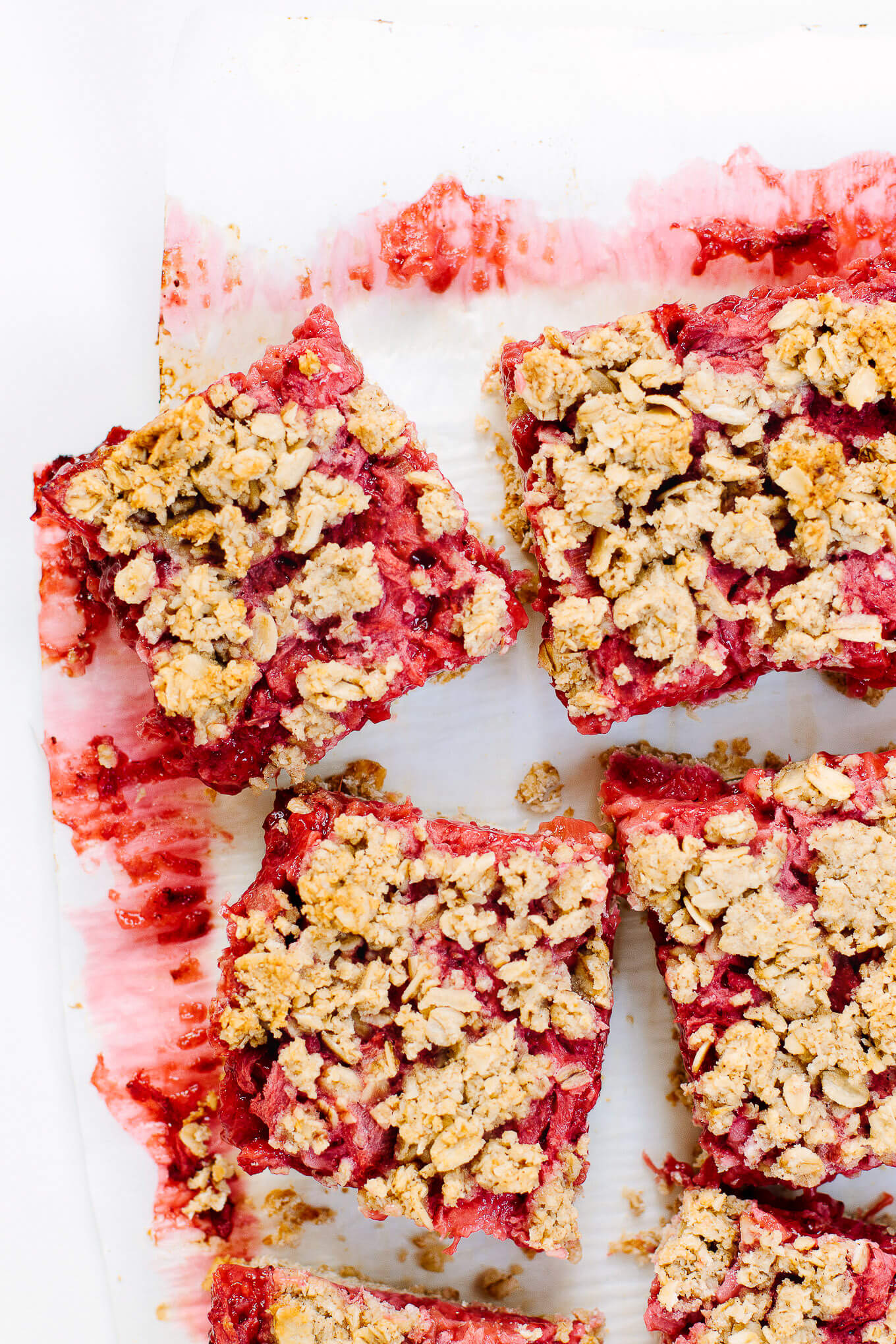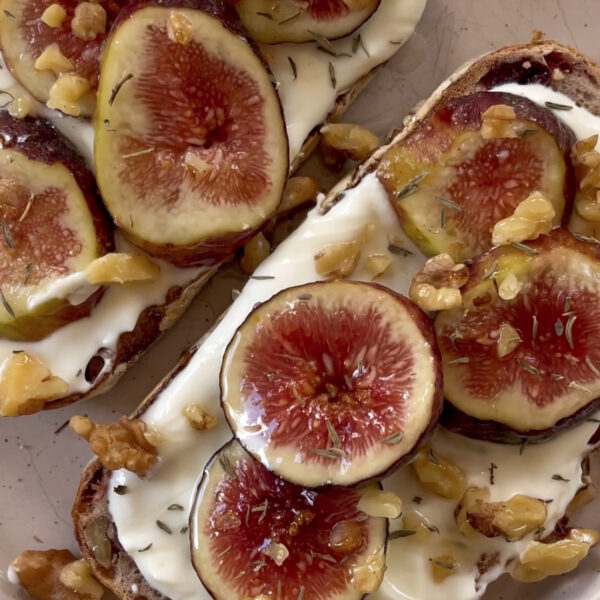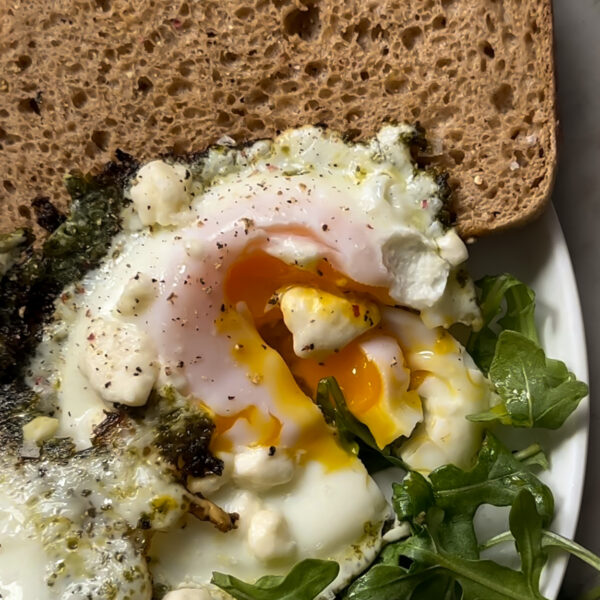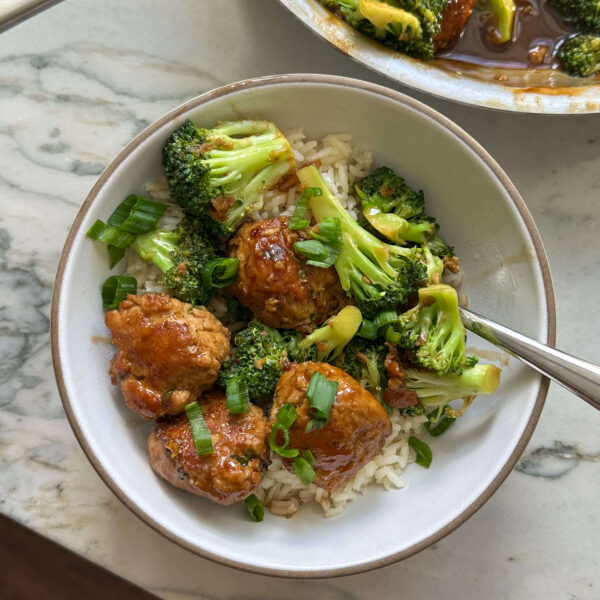These strawberry rhubarb crumble bars have been on repeat over the past couple of weeks. Partially because of recipe testing but also because they are just that good! While these are a wonderful summer dessert, I’ve been enjoying them for an afternoon snack, sometimes warm, sometimes straight from the fridge. Either way, they’re delicious!
Strawberry Rhubarb Crumble Bars
These crumble bars are fairly simple and lend to both fresh or frozen fruit. Strawberry and rhubarb come together with lemon juice to make a tart, sweet filling which gets nestled between a lightly sweetened crumble dough made from oats, almond flour, coconut oil and applesauce. As the crumble bakes the natural sugars from the fruit condense and caramelize, leaving a thick and delicious jammy filling. The crumble dough is reminiscent of a lightly spiced oatmeal cookie – dense and buttery (without any butter!). The coconut oil adds healthy fat and sweet flavor while the applesauce provides moisture and a natural sweetness. These bars satisfy a sweet craving and won’t leave you with a sugar crash. Pretty perfect, in my opinion.


Fresh or frozen – which is more nutritious?
Frozen fruit and veggies are often overlooked or misinterpreted as less nutritious, but research shows that this may not be the case. Numerous factors play a role in the nutrient density of produce. The soil it’s grown in, when it is harvested, and how long it sits before consumption all play a role.
Just because produce is fresh and sitting on the grocery store shelf doesn’t mean it superior to frozen in nutrients or taste. In fact, most produce is picked before its peak ripeness, which means it has not had the chance to develop all of its vitamins and minerals (aka: not as nutrient dense). On the other hand, produce that is destined for the freezer is allowed to ripen fully before harvesting. Once the produce is picked it is flash frozen (vegetables are blanched beforehand) and the nutrients are locked in.
Research shows that frozen fruits and vegetables are just as nutritious or more so than fresh. For reference, one study published in the Journal of Agricultural and Food Chemistry studied vitamin C, riboflavin, vitamin E and beta-carotene in frozen and fresh food samples and found that the vitamin content of the frozen foods was comparable and occasionally higher than their fresh counterparts (with the exception of beta-carotene).
I think we can all agree that growing your own produce or getting it from the farmer’s market will be the most nutrient dense, tastiest you’ll find. But I get it, that is not always an option! Since there are numerous factors that play a role in the nutrient profile of the produce we find in the grocery store or at the local farmers market, the key is to know when it may be more beneficial to purchase frozen over fresh.
Six things to consider:
-
- Season – eating produce when it is in-season is superior in both taste and nutrition. Have you ever had a strawberry in winter and realize it’s just not bursting with the sweet flavor of the strawberries you eat in June and July? While it is possible to get most produce all year around, it is more nutrient dense, flavorful and budget friendly when purchasing it during its natural harvest season.
- Cost – frozen produce can be a huge cost saver, especially when it comes to purchasing organic. Unless it is peak season for a particular fruit or vegetable, frozen may be the way to go if your budget is tight. Even if you find frozen produce cost slightly more, it may be a cost saving purchase since there is no potential of spoilage.
- Taste – fruit and vegetables are most flavorful when fully ripe and eaten closely after harvesting. If you are able to grow your own produce or get locally sourced fruits and vegetables fresh at the farmer’s market, this is often some of the most flavorful produce. If you do not have access to this, frozen may be the way to go since fruit and vegetables destined for freezing are often allowed to fully ripen before harvesting.
- Texture – frozen fruit can have a compromised texture. This happens because as the water inside the cell walls freezes, it expands and ruptures the cell wall of the plant. Once thawed, produce has a softer texture than when fresh. However, this may not have a huge impact depending on the way you use the fruit or vegetables.
- Use – Since frozen produce has a slightly compromised texture, the way you plan on using it can make a difference. Cooking and blending also break down the cell walls, making frozen fruits and veggies perfect for smoothies, soups or sauces.
- Convenience – frozen produce can be kept around a lot longer than fresh, meaning you can it on hand without having to worry about spoilage and food waste. Having a stock of frozen produce can help add a variety of fruits and vegetables into your diet without having to worry about not using it up before it goes bad.
It may be easier to gravitate towards the array of fresh produce at the market, but I encourage you to consider adding frozen produce into your weekly grocery haul. Your wallet and taste buds may thank you. Now stock up on some fresh or frozen fruit and go make these crumble bars.

IF YOU LOVE THESE Strawberry Rhubarb Crumble bars, YOU’LL ALSO ENJOY THESE RECIPES:
-
- Mixed Berry Crumble Bars
- Strawberry Oat Crumble Bars – Detoxinista
- Raspberry Crumble Overnight Chia Oats – Dolly and Oatmeal
- Oat & Apple Crumble Bars – Occasionally Eggs
- Blueberry Rhubarb Crumble Bars – Love Me Feed Me
Strawberry Rhubarb Crumble Bars
Tart, sweet strawberry rhubarb filling nestled between a lightly sweetened crumble dough made from oats, almond flour, coconut oil and applesauce.
Makes 12 bars
Ingredients
For the Crumble:
- 2 1/2 cups rolled oats (divided)
- 1/2 cup almond flour
- 1/4 cup coconut oil
- 1/4 cup maple syrup
- 1/4 cup applesauce
- 1 teaspoon vanilla extract
- 1 teaspoon baking powder
- 1/2 teaspoon cinnamon
- 1/2 teaspoon salt
For the Filling:
- 3 cups sliced strawberries (fresh or frozen)
- 1 cup sliced rhubarb (fresh or frozen)
- 3 tablespoons arrowroot powder
- 2 tablespoons lemon juice
Instructions
Preheat oven to 350°F. Line an 8×8 square baking pan with parchment paper and set aside.
Add two cups of rolled oats to an upright blender, or food processor fitted with a metal “s” blade, pulse the oats until ground down into a flour. Transfer to large bowl, add the remaining 1/2 cup rolled oats and the rest of the crumble ingredients. Using a spatula or your hand combine the ingredients until the dough begins to stick together. You want everything to be moist and come together. It can be slightly crumbly, hence the name.
Measure a heaping 1/2 cup of the dough for the topping and set aside. Spread the remaining dough evenly into the prepared pan. Press firmly and flatten into the bottom, sides, and corners. It may help to slightly oil or wet your fingers or spatula.
Wipe out the food processor and add the strawberries and rhubarb. If using frozen fruit make sure it is slightly thawed. Pulse 5-6 times until the fruit is broken down into small pieces. Transfer to a mixing bowl and add the arrowroot powder and lemon juice.
Spread the filling evenly over the crumble crust. Take the remaining crumble dough and use your fingers to break it up evenly over the fruit filling. Gently push the crumble dough into the filling to set. Bake for 35-40 minutes, until the top is golden brown and filling is bubbling. Let the bars cool completely before slicing.
They can be eaten cold or warmed up slightly. Store in an airtight container in the fridge for up to 5 days.
Notes
This recipe calls for fresh or frozen fruit. I’ve tried it both ways based on what I had on hand and both worked well. If using frozen fruit, let the fruit thaw slightly before measuring it, as frozen fruit tends to take up more volume.
You can substitute other fruits, just know know some fruits require more or less starch to firm up. This shouldn’t make that much of a difference. However, this King Arthur Flour Pie Thickener Guide is a good reference for fruit to starch ratio.
DID YOU MAKE THIS RECIPE?
I’d love to hear how it turned out for you! Leave a comment below and share a picture on Instagram with the hashtag #nourishedbynutriton.





This was delicious! So easy to make. My kids and hubby LOVED it too! Thanks for a great recipe!
Thank you very much for sharing this recipe :) My bars turned out absolutely delicious (here I posted a pic @eddywina0408). I used 3 cups of rhubarb and only 5 strawberries to make the filling a little sweeter and added some pecans to the topping. This recipe is definitely a keeper – healthy, tasty and easy to make. I´ll for sure try it with different fillings.
Your bars look perfect! The pecan addition sounds like a wonderful addition for some extra crunch. I can’t wait to see the other flavors you try! Right now, I have recipes for mixed berry and apple on the site!
[…] in between oatmeal crumble. These healthy apple crumble bars are a fall-inspired version of my strawberry rhubarb crumble bars and mixed berry crumble bars. They’re like a portable apple crisp. The fresh apples turn into […]
[…] starts to warm I’m dreaming of summer berries and all the ways to use them. Since you all love my strawberry rhubarb crumble bars, it only felt right to make a mixed berry version. The sweet, juicy berries turn into a thick layer […]
[…] Strawberry Rhubarb Crumble Bars […]
[…] Strawberry Rhubarb Crumble Bars via Jessica Kelley MS, RD of Nourished by Nutrition […]
These look ABSOLUTELY delicious. Will have to add this my list of things to bake and share with you the results :)
Thanks so much for sharing!
Vanessa
http://www.modernflourish.com
Oh Vanessa, I would love that!! I appreciate you stopping by here to leave your comment!
[…] year round, purchasing or harvesting fresh herbs in the midst of peak growing season ensures the best flavor and nutrition (just like other produce!). I love keeping fresh herbs on hand to ensure a bright and flavorful […]